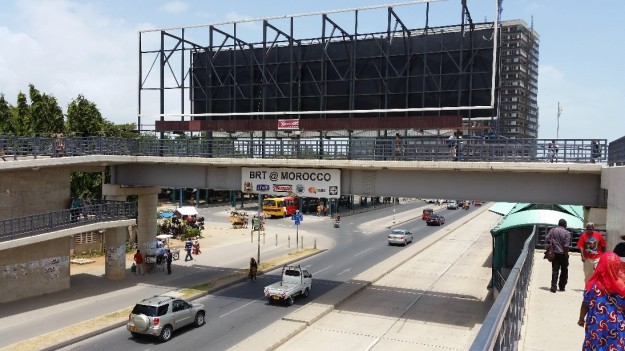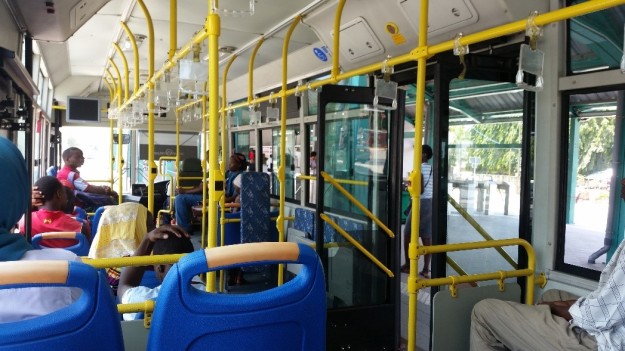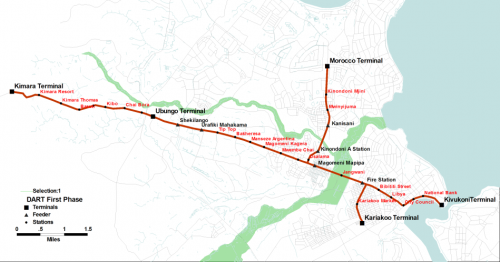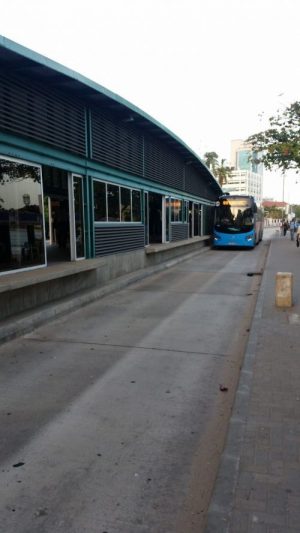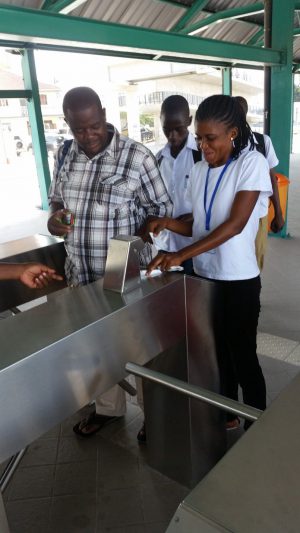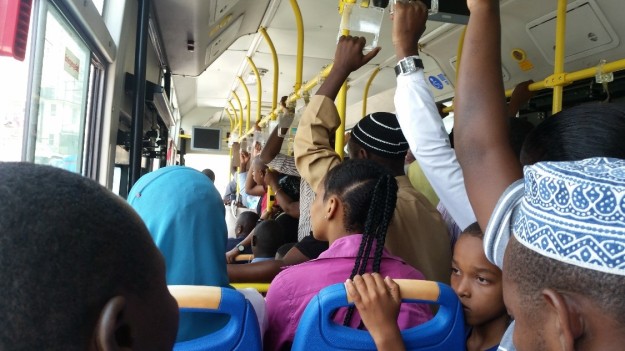Simon Batchelor of Gamos writes on his experiences with the Dar Es Salaam rapid transit system (the DART).
When SAMSET started in 2014, its first network meeting was in Dar Es Salaam alongside an ICLEI conference. At the conference there was an offering by the mayor of Dar for attendees to have a field trip to see the Dar es Salaam bus rapid transit system called DART. At that time there was little more than road works to see, but what was impressive was the ambition to carve out whole highways that would be bus only roads.
Morocco BRT terminal in Dar Es Salaam. Image: Simon Batchelor
Like most city wide infrastructure projects, the system has been in the planning for more than a decade. Discussed in 2003, JICA encouraged Dar municipality to consider the system, and designs started in about 2005. Consultations with the public and those affected by the construction, social and environment impact studies, ongoing economic feasibility studies all take time, so it wasn’t until 2012 that the road works started to appear. It will eventually be 6 phases, but phase 1 was completed in April 2015 (about 6 months after our first network meeting – so we didn’t get to ride it then).
When looking for some of the facts surrounding the system, I came across a document – “What necessitated establishment of a BRT system in Dar es Salaam?”. Their answer…”When you have a swelling city population and you find yourself in the teeth of agonizing transport problems and hitches, the logical safety valve is to have a type of public transport that uses a passenger medium uninterrupted. As the name suggests BRT is a mode of public transport that uses rapid trunk buses. BRT is a huge-capacity transport solution to public transport problems the City of Dar es Salaam faces. The BRT system operates in a way quite similar to a tramway. In the latter passengers board trams while in the former passengers ride on huge buses plying on exclusive lanes.” (My emphasis)
Interior of one of the DART buses. Image: Simon Batchelor
So when we were in Dar for other business last week, we took the opportunity to ride the buses. Phase 1 is said to be a single 23 km line from a station called Kimara Terminal down to the CBD. However we found ourselves at the end of a branch line, at Morroco Terminal. The system is said to have cost around $180 million so far. Since there are branches one has to choose the right bus. We got on at Morroco, and were advised to take the No 3 bus in order to get to the Zanizbar ferry terminal.
Proposed full route of the DART. Image: http://ansoncfit.com/wp-content/uploads/DART-Phase-1-e13033701609191.png
Citizens riding the DART bus. Image: Simon Batchelor
It runs some 140 Chinese made buses that in themselves are unusual. Each station or terminal sits raised at about stomach height. The buses have floors and doors at that height on the right hand side. On the other side for emergencies they have one door that has steps down to road level – mainly for the driver since no one ever gets on that left hand side.
Bus terminal in Dar Es Salaam. Image: Simon Batchelor
The terminals have gates and one purchases either a seasonal ticket and gets a Contactless smart card or at the counter and gets a printed ticket with a bar graphic. Placing the ticket under the gate scanner gets you through the gate or like many other rapid transport systems in cities one taps the card and the price of the journey is taken from it. At the moment there are staff to help people get through the gates as the whole system is still being nurtured among the general population.
Passengers using a ticket turnstile. Image: Simon Batchelor
We entered the bus at one end of the line (Morroco), and found a clean air conditioned No 3 bus that would not have felt out of place in any modern bustling city. By mid journey the bus was full and the heat radiated by so many bodies had overwhelmed the air conditioning and people had opened the windows. This was not rush hour but was middle of the day, so I can imagine it gets pretty cramped at peak times. However while it declined in comfort by the end of the journey, it was indeed quick. We had sat in a taxi the day before for an hour in a very slow moving traffic jam; this trip took us only 20 minutes. It felt impressive to look ahead of the bus and see the completely open highway.
Passengers on the DART. Image: Simon Batchelor
We have talked a lot in this blog about the growing needs of municipalities, and SAMSET is focused on long term solutions. Dar es Salaam is a fast growing commercial capital, producing 70 percent of Tanzania’s gross domestic product and is the hub of economic activity with an estimated daytime population of close to six million. Analysis in 2014 showed that some private 5,200 passenger buses were operating on the city roads, and traffic congestion was already having an impact on the economic well-being of the city. A metro was not possible, and the rapid bus system seemed viable. It is said it will transport 300,000 a day in this interim phase.
Having now ridden the system, I can see how it can avoid the traffic problems. I think it probably already gets overwhelmed in rush hour and be uncomfortable to ride at those times (much like most mass transit systems in most capital cities! I try to avoid the London underground at peak times!). I wish the municipality of Dar the best for its subsequent phases and will be interested to see its longer term use of lower carbon buses.

